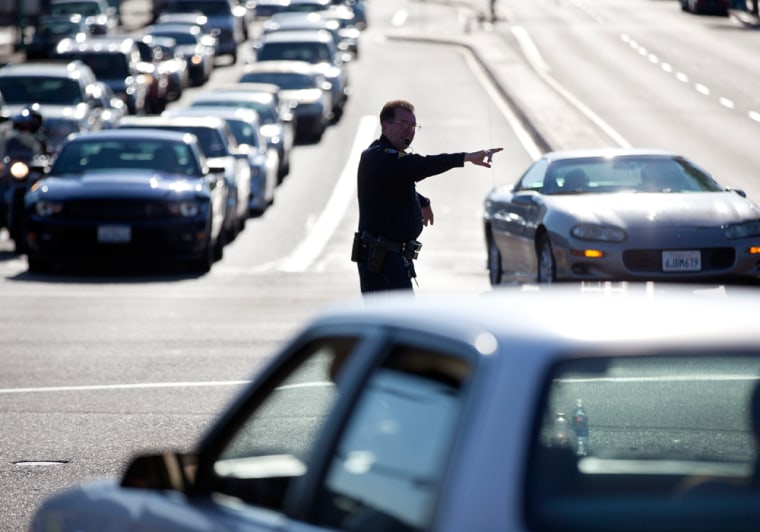A major power outage knocked out electricity to up to 5 million people in California, Arizona and Mexico on Thursday, bringing San Diego and Tijuana to a standstill and leaving people sweltering in the late-summer heat in the surrounding desert.
San Diego bore the brunt of the blackout that started shortly before 4 p.m. PDT., darkening much of the nation's eighth-largest city. All outgoing flights from San Diego's Lindbergh Field were grounded and police stations were using generators to accept emergency calls across the area.
The blackout extended east to Yuma, Ariz. where more than 56,000 people were left in the dark; power was restored there about five hours later.
Pockets in California and south of the border in Baja California. But most of the people in the darkened swath were expected to spend the night without power.
California public health officials in Sacramento activated the state's Joint Emergency Operations Center to assess the impact. The move alerts government agencies and other entities to report any medical or public health effects, starts efforts to assess the impact on hospitals and nursing homes and on the public drinking water and regulated food industries.
As of about 9:15 p.m. local time, no reports of critical problems were received, health officials said in a statement.
SDG&E officials said there was a problem with a transmission line from Arizona to Southern California that caused both major connections to the region to go out.
In a press release Thursday night, the Arizona Public Service said one of its employees was carrying out a procedure at a substation northeast of Yuma that caused the problem. The utility said the resulting power failure should have been isolated to the Yuma area. An investigation into why it was not is under way, the utility said.
That problem caused the two reactors at the San Onofre nuclear power plant on the coast north of San Diego to go offline at 3:38 p.m. Charles Coleman, a spokesman from Southern California Edison, said the reactors are programmed to do that when there is a disturbance in the power grid, and there was no danger to the public or to workers there.
"Essentially we have two connections from the rest of the world: One is from the north and one is to the east. Both connections are severed," said Mike Niggli, SDG&E's chief operating officer, said at a news conference.
In a press release Thursday night, the Arizona Public Service (APS) said one of its employees was carrying out a procedure at a substation northeast of Yuma that caused the problem. The utility said the resulting power failure should have been isolated to the Yuma area. An investigation into why it was not is under way, the utility said.
"This was not a deliberate act. The employee was just switching out a piece of equipment that was problematic," said Dan Froetscher, a vice president at APS.
Niggli and FBI officials had earlier ruled out terrorism. "To my knowledge this is the first time we've lost an entire system," Niggli said.
Roads in San Diego were gridlocked with power out to traffic lights, and Mayor Jerry Sanders asked citizens in a tweet to stay off roads and keep landline phones clear for emergencies.
Gas stations can't pump gas and mobile phone networks were spotty, University of San Diego Professor Alan Gin said by phone. "Virtually every street light is out," he said.
In southern Orange County, the sheriff's department dispatched deputies to busy intersections because traffic lights were out, said John McDonald, a sheriff's spokesman.
At San Diego City Hall, some people were trapped in elevators, but were
San Diego police spokeswoman Andra Brown said that 13 police stations were without power but were able to continue operating and taking 911 calls by using generators.
Residents in parts of eastern San Diego County and Yuma, 170 miles east of San Diego, endured sweltering temperatures with no air conditioning.
"It feels like you're in an oven and you can't escape," said Rosa Maria Gonzales, a spokeswoman with the Imperial Irrigation District in California's sizzling eastern desert. She said it was about 115 degrees when the power went out for about 150,000 of its customers.
Many of the Tweets from San Diego residents revolved around air conditioning. "I'm going to die of heat in this house with no AC!" wrote Ashleigh Marie. "What am I supposed to dooo."
But San Diego resident Kiersten White tweeted that the power outage "makes me glad I don't have air conditioning to begin with ... nothing to miss!"
Other people were having a harder time. "Trapped outside of our rooms at the hotel," tweeted Rob Myers, visiting San Diego from Washington. Other members of his party got trapped in an elevator, he wrote.
Blackouts hit Mexico's Northern Baja California state in the afternoon, knocking out power to hundreds of maquiladora export assembly plants in the sprawling industrial powerhouse of Tijuana, south of San Diego.
The blackouts knocked out stop lights at intersections across Tijuana, causing traffic snarl ups, and also cut power to hospitals and government offices.
In the desert heat of the Palm Springs area, the temperature was 111 on Thursday, with rolling blackouts. The Eisenhower Medical Center will serve as an oasis of air conditioning since it operates on its own power source, said hospital spokeswoman Deborah Johnson.
Johnson welcomed fragile seniors and others affected by the heat to cool off in their lobby.
"All I can say is God bless air conditioning," she said.
